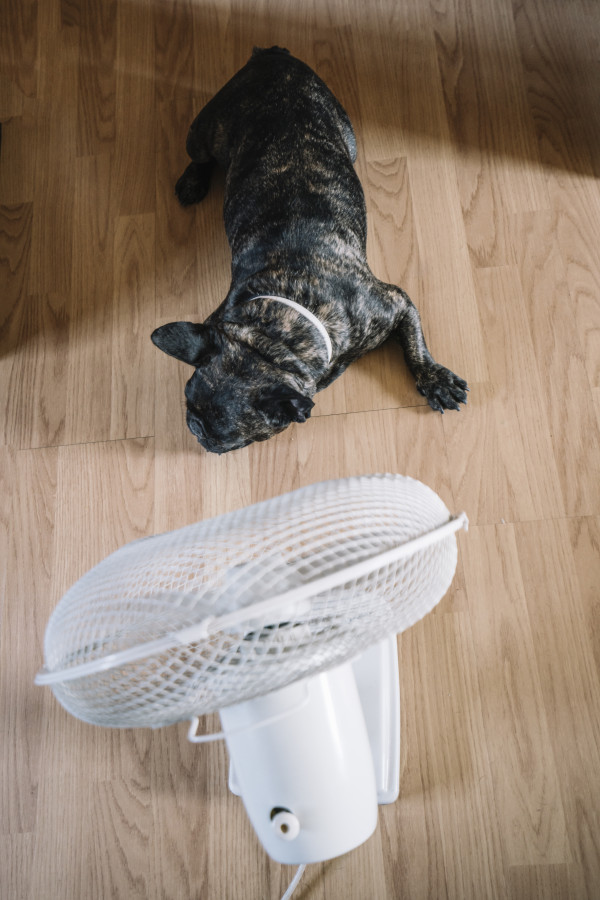
Heat Stroke, Sunburn & More: What Every Pet Parent Needs to Know This Summer
Summer invites us outdoors to enjoy the sun, backyard barbecues, and long adventures with our pets. But while we soak up the warmth, our furry (and sometimes fur-less) companions face unique and serious risks. Dogs and cats cannot regulate their body temperature as efficiently as humans, relying primarily on panting and limited sweat glands in their paws. This makes them more susceptible to heat-related illnesses, sunburn, burns from hot surfaces, and other seasonal hazards, such as fleas, ticks, and even barbecues. Understanding these threats and knowing how to prevent and respond to them is essential to keeping your pet safe.
The Hidden Danger of Heat: Heat Exhaustion and Heat Stroke
As temperatures rise, pets can quickly develop heat exhaustion, which can progress to heat stroke if not addressed promptly. Heat exhaustion begins when a pet’s internal temperature climbs above their normal range (about 100.5°F to 102.5°F for dogs and cats). Once it surpasses 106°F, it becomes heat stroke, a true emergency that can lead to organ failure and death.
Early signs of heat-related illness include excessive panting, drooling, weakness, confusion, vomiting, diarrhea, and red or pale gums. Without swift intervention, these symptoms can progress to collapse and seizures. If you suspect your pet is suffering from heat stroke, immediately move them to a shaded area, gently apply cool (not ice-cold) water to their belly, paws, and armpits, and offer small sips of water if they are conscious. Seek veterinary care immediately. According to the American Veterinary Medical Association (AVMA), heat stroke is a critical emergency that requires prompt professional treatment.
To prevent heat exhaustion, limit walks and outdoor play during the peak heat hours (10 a.m. to 4 p.m.). Always provide shade, fresh water, and never leave pets in parked cars. A car’s interior can become deadly in minutes, even with cracked windows, as highlighted by the Humane World for Animals.
Sunburn: A Surprising Risk for Many Pets
It’s not just humans who need sun protection. Pets, particularly those with light-colored or thin coats, hairless breeds, and animals with shaved fur, are prone to sunburn. White or lightly colored dogs and cats are especially vulnerable. White horses also face similar risks; their pink-skinned areas can burn easily, leading to painful sores and skin cancer over time.
Common sunburn symptoms include redness or pinkness of the skin, tenderness, hair loss in affected areas, and, in severe cases, peeling or open sores. Areas most at risk are the nose, ears, around the eyes, and the belly, where fur is sparse.
If your pet gets sunburned, move them out of the sun immediately, apply cool compresses, and consult your veterinarian for further treatment. Prevention is critical: limit sun exposure during peak UV hours, and use pet-safe sunscreen—never human sunscreen, as it often contains zinc oxide or para-aminobenzoic acid (PABA), both of which are toxic to pets if ingested.

Photo by ADDICTIVE_STOCK
Hot Pavement and Paw Burns
Pavement and sand heat up dramatically under the summer sun, posing a serious threat to your pet’s paws. When the air temperature is just 77°F, pavement can reach 125°F. At 86°F, asphalt can soar to 135°F, hot enough to cause severe burns within seconds.
Pets suffering from paw burns may limp, refuse to walk, lick or chew their feet excessively, or show visible damage like darkened, blistered, or cracked paw pads. Immediate treatment involves gently rinsing the paws with cool water, applying a pet-safe paw balm, and consulting a veterinarian if the damage is severe.
To protect your pet, avoid walking on hot surfaces during midday hours. Walk early in the morning or later in the evening and test the surface by holding your hand or bare foot on the pavement for at least seven seconds; if it’s too hot for you, it’s too hot for them. Consider using paw wax or protective booties, although some pets may need time to adjust to wearing them.
The Danger Lurking in Cars
Even on seemingly mild days, the temperature inside a car can quickly become deadly. With an outside temperature of 70°F, a car’s interior can reach 110°F in just 10 minutes, and 139°F within 30 minutes, according to the AVMA. Pets left in vehicles face a high risk of heat exhaustion and heat stroke, often with fatal consequences.
The best prevention is simple: if you cannot take your pet with you when leaving the car, leave them at home where it is safe and cool.
The Often-Overlooked Dangers of Barbecues
Summer barbecues can be fun for families, but present numerous hazards for pets. Grilled meats and skewers can be irresistible temptations but pose choking hazards or cause internal injuries if swallowed. Cooked bones can splinter, leading to gastrointestinal blockages or tears.
Fatty scraps and drippings can cause pancreatitis, a painful and potentially serious inflammation of the pancreas. Onions, garlic, grapes, raisins, and certain sauces are toxic to dogs and cats and can cause serious or even fatal health problems.
Additionally, lighter fluid and matches contain harmful chemicals, and citronella products used to deter insects can cause severe respiratory or nervous system issues if ingested or inhaled. Alcohol is also highly dangerous to pets and should always be kept out of reach.
Always supervise pets during outdoor gatherings, keep human foods out of their reach, and dispose of trash promptly. Additionally, ensure that guests are aware not to feed your pets under the table.

Photo by akportfolio24
Fleas and Ticks: Small Parasites, Big Risks
Warm, humid summer weather fuels an explosion in flea and tick populations. Fleas can cause intense itching, skin infections, hair loss, and severe anemia in extreme cases. Ticks, meanwhile, are notorious for transmitting diseases such as Lyme disease, ehrlichiosis, and anaplasmosis, all of which can lead to long-term health complications.
After spending time outdoors, especially in wooded or grassy areas, carefully inspect your pet’s entire body for ticks. Look between toes, inside ears, in their mouth between teeth, around the neck, by the tail, and under collars.
Veterinary-approved prevention products, such as topical treatments, oral medications, and tick collars, are the best defense. Keep your yard trimmed and remove brush piles to reduce tick habitats. If you find a tick, remove it promptly (and gently) using fine-tipped tweezers and monitor your pet closely for signs of illness in the weeks that follow.
A Season to Enjoy—Safely
Summer adventures can be some of the most joyful memories you share with your pets, but they require extra awareness and planning. Always ensure your pet has access to shade and cool water. Avoid peak heat hours, check their paws for burns, protect against parasites, and be vigilant during barbecues and social gatherings.
By understanding these risks and taking proactive measures, you can help your furry (or feathered, or hooved) friends stay safe and comfortable all season long.
For more expert guidance and seasonal safety tips, explore these trusted resources:
Our pets rely on us to keep them safe, especially when the sun is blazing and the days are long. By planning and learning about seasonal hazards, we can ensure they have a fun, safe summer filled with happy memories, not emergency vet visits.
To learn more about general summer and water safety for pets, check out my previous articles: “Summer Pet Safety: A Guide to Heat, Water, and Seasonal Hazards,” and “Splash Safely: Water Hazards Pet Parents Should Know This Summer.”
Follow us on LinkedIn for the latest updates on all things happening here at BSM Partners.
About the Author
Lee Ann Hagerty is Director of Customer Enrichment and Consumer Insights on the BSM Product Innovation team with 29+ years in the pet food industry, working for Iams/Eukanuba, Procter & Gamble, and Mars Pet Care. She brings a unique combination of project management skills with consumer insights, product design, animal nutrition, and sensory science which drives an in-depth understanding of the pet and consumer. Lee Ann has a passion for helping dogs. Over the last year and a half, she has fostered over 22 dogs. Many of them were senior dogs who had lived their entire lives outside as hunting dogs. She has been a foster pet parent for many years, and it brings her great joy to see these pets find fur-ever homes where they live with families indoors with love and care.
This content is the property of BSM Partners. Reproduction or retransmission or repurposing of any portion of this content is expressly prohibited without the approval of BSM Partners and is governed by the terms and conditions explained here.